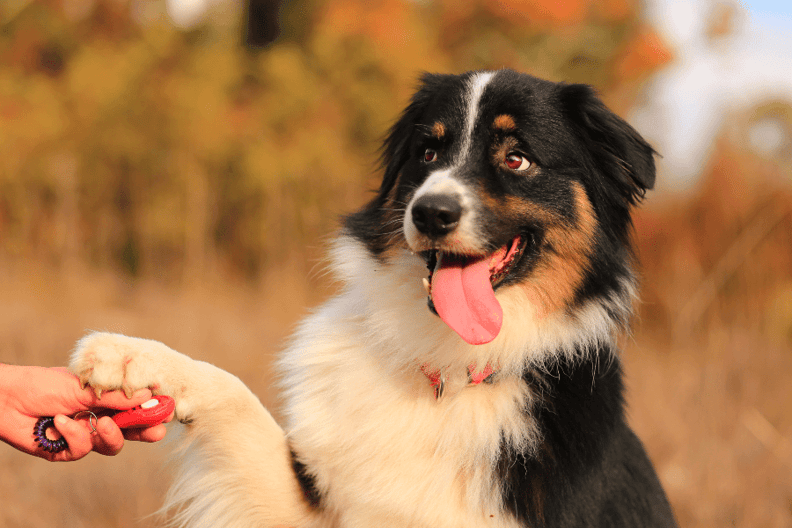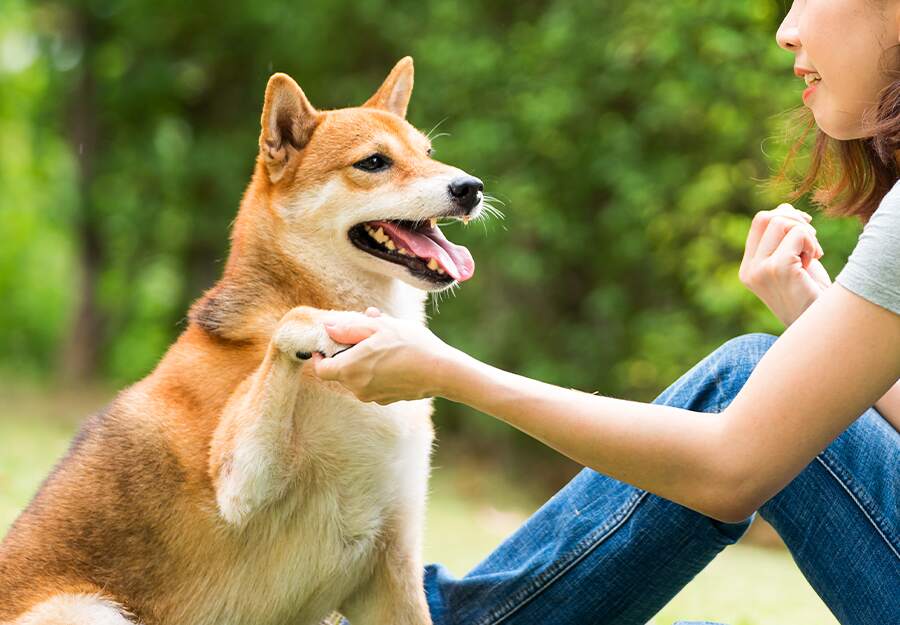
If you are a first time pet owner, then getting a new dog might seem a bit intimidating. These essential dog training tips will help start any new dog owner on the road to a well-behaved pooch.
A new dog is an exciting time in a person’s life as they get a new friend and companion. However, when you get a new dog, you also need to be sure to train it. If not, you could have a badly behaved pet that destroys your home and terrorizes any visitors you have over.
Unfortunately, training a new dog (especially as a first-time dog owner) isn’t always easy. They can be notoriously stubborn and simply might not want to listen to what you have to say.
To help get you started, here are some dog training tips and tricks to give you the best chance of successfully training your new dog.
Exploring Dog Training Methods
Whether you choose dog training at home or you opt to enroll Fido in a professional class, you’ll probably feel bombarded with dog training methods and techniques. Many are considered the best dog training techniques, but what works for one pooch might not work for another.
The three core dog training philosophies are The Dominance Method, the Scientific Method, and Positive Reinforcement.
The dominance and scientific method are often considered outdated. Most professional trainers now recommend positive reinforcement as the safest and more effective dop training style. And we agree!
Check out this post from Dogingtonpost.com for more information about these training methods.
Many of the aversive techniques in the Dominance and Scientific methods are easy to use incorrectly without professional guidance. Positive reinforcement training or force free dog training is the idea of rewarding positive behaviour and ignoring negative behaviour.
This method has been shown to be highly effective and easy for beginners and new pet parents. Here are some of the best positive reinforcement training styles that anyone can learn:
Treat Training
With positive reinforcement training, a dog will repeat the request in order to receive ample praise and a treat. This popular technique helps to reinforce the bond between the pet and the handler. Another bonus to this training style is that treats help to associate behaviours and situations with positive feelings.
Things that might have once seemed overwhelming or scary for your dog can be an experience they enjoy and look forward to. A good example of this is dog crate training.
How to Treat Train Your Dog
Treat training is relatively simple. Ask your dog to do something, and give them a reward for responding correctly. It’s the most popular method for training a dog and often gives quick results when it comes to basic commands and obedience training.
Though the concept is simple, there are some techniques in dog treat training that can make the method more effective.
-
-
- Timing is key. Make sure you are prepared to reward quickly after the requested behaviour is given. Tools like a dog treat pouch makes it easy for you to keep tasty rewards at arm’s length.
- Repeat often. Dogs learn best by repetition, so even after your dog has mastered the trick or behaviour, keep practicing.
- Be Consistent. Using the same vocal commands, hand motions, and even tone when training can help your dog learn faster. Inconsistencies can confuse your dog, making it harder for him to recognize what you are asking of him.
- Too many treats can be a problem. While treat training is effective, it must be factored into your dog’s diet. The extra calories and nutrients from treats can lead to overfeeding, unwanted weight gain, and encourage poor mealtime habits.
- Be cautious of treat addiction. Some dogs become treat-obsessed and may refuse to comply with routines and commands without the promise of an edible reward. This can lead to behavioural issues.
-
Treat training is an excellent tool for training your new dog, but should not rely on too heavily. Once your dog has mastered a command, start to find non-treat ways to reward them. Clicker training, vocal praise, or a loving scratch on the neck are some of the ways you can reward your dog without the use of food.
Make sure you are sticking to high-value and healthy training treats. Check out our treat training eBook for more tips.
Clicker Training
Have you ever heard of clicker training? Though not as popular as treat training for dogs, clicker training uses a similar technique. Before rewarding your dog with food, you train them to recognize the click as positive praise.
Clickers are effective because they provide a fast and unmistakable sound that your dog can learn to recognize as a sign of good behaviour. Unlike vocal praise that’s often received differently depending on tone and situation, the click will be a consistent sound to tell your dog, good “job!”
How to Train a Dog with a Clicker
A clicker is a small hand-held device that, when pushed, produces an audible click noise. The noise acts as a signal to your dog that they have correctly responded to a command or has demonstrated positive behaviour.
The best way to introduce a clicker is to follow the click sound with a treat. Do this 10-20 times until your dog recognizes the sound and anticipates the reward. Eventually, you can replace treats with another reward, like vocal praise or a toy, if you wish to wean your dog off of treats, but food s often the most effective reward.
Here are a few clicker training tips to help get you started:
-
-
- The clicker is not a remote. Try to click during the behaviour if you can, or at least immediately after the behaviour. The timing here is important. A treat or other reward can come after the click. Clicking before the action is more like a bribe than a reward and will not be an effective training technique.
- Click quickly. When training, keep the clicker in your hand so that you can click immediately after your dog has done what he was instructed to do. A treat, if part of your training, can come after the click.
- Click only once. Multiple clicks will not enhance the enthusiasm for the reward. Click once, and use treats or vocal praise to express excitement about a particularly difficult trick.
- Reward good behaviours, even when you didn’t ask. Some basic commands like sit, lay down, come, or stay are going to be natural parts of your dog’s day. If you find your dog performing a positive action at an appropriate time, give them a click to know that they’ve used this behaviour correctly.
- Know when to stop clicking. Clickers are excellent for teaching new behaviours, dealing with new situations, or re-training dogs that are out of practice. This means that when a command or behaviour is learned, the clicker is no longer needed for that behaviour. Keep rewarding, either with treats or vocal praise, but there is no need to use the clicker forever!
-
Try the Clix Multi-Clicker to get started. The comfortable tear-shaped design and raised button make it easy to react quickly to your dog’s actions. It comes with a free training guide, too!
Hand Signals for Dogs
Another technique for teaching your dog is to use hand signals. While this is a vital technique for dogs with hearing impairments, all dogs can benefit from the incorporation of hand signals in their training. The hand signals are visual cues that can either replace or complement a vocal cue.
Hand signals on their own may not be as effective, but when combined with vocal cues and clicker training can make dog training easy and efficient. Check out Hand Signals for Dogs for some of the most common dog hand signals and how to use them.
How to Train Dogs Using Hand Signals
Using a visual cue, like hand signals, is a great way to enhance your dog’s training. It is best used with short and simple commands, but many of the basic commands are used in most aspects of your dog’s daily routines.
To help get you started, here are a few tips for using dog sign language:
-
-
- Combine visual and vocal commands together. Using hand signals with a vocal command helps your dog understand the action. It is also helpful for keeping your dogs attention in a noisy environment.
- Keep your hand motions simple. A quick and easy hand motion will be easy for your dog to learn than ones that require multiple movements. This helps keep your different hand motions unique and hard to mix up.
- Pick one hand signal per word. Just like your vocal commands, you should choose a single-hand motion for each action. Consistency is very important.
- Start with eye contact. Getting your dog’s attention is the first step in offering a visual cue. If he’s not looking at you, then he’s not going to benefit from the hand command. He will also be less likely to get distracted and fail to respond to a vocal command, as well.
-
If you start out with one dog training approach but feel it doesn’t fit a pet’s particular needs then you can always try something new.Listen to a dog trainer you trust and enroll in puppy obedience training to pave the way for a lifetime of dog training success.
Top 10 Dog Training Tips
Whether you are training your dog to sit, to be housetrained, or anything else, the training tips in this article will help the process be as simple as possible.
1. Don’t Be Afraid to Use Treats
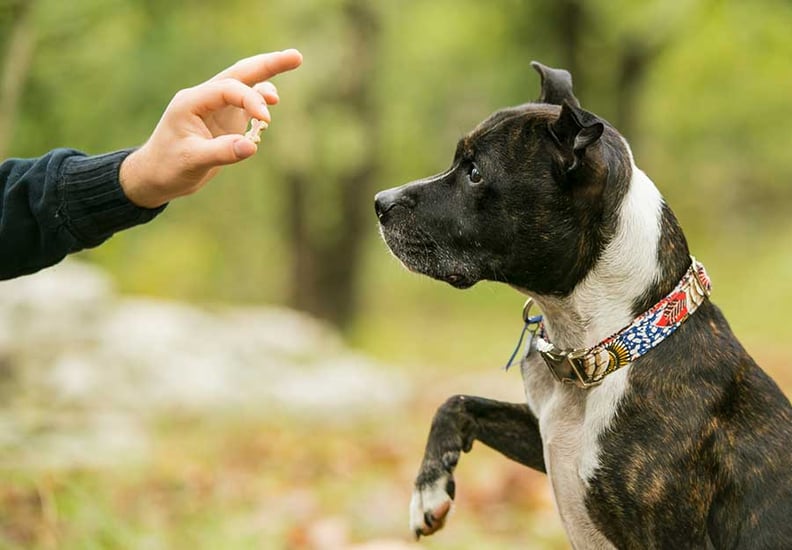
There is no doubt that dogs like treats. No matter what they are doing, most will come running if you’re about to give them a treat. This can make treats an incredibly effective tool for training dogs. They can be used to reward good behaviour, or even to get the dog to complete the desired action.
You can even use treats when you’re not home. For example, try a dog camera that dispenses treats so you can encourage and reward good behaviour even when you’re out and about. Of course, treats shouldn’t always be relied on to get dogs to do what you want, but they can be an essential tool early on while building and encouraging good behaviour.
2. Don’t Wait Too Long to Start Training
When you get your new dog, you shouldn’t wait too long before you start training it. The longer the dog goes without sufficient training, and the older it gets, the harder training it will be. While puppies have short attention spans, they can generally learn certain commands within their first few weeks of being alive.
While training quickly is a good idea, this also depends on the age of the dog for certain kinds of training. For example, most dogs don’t get good control of their bladder until they are around 12-16 weeks old. So if you try to potty train them before then, it might not be very effective.
3. If at First You Don’t Succeed…
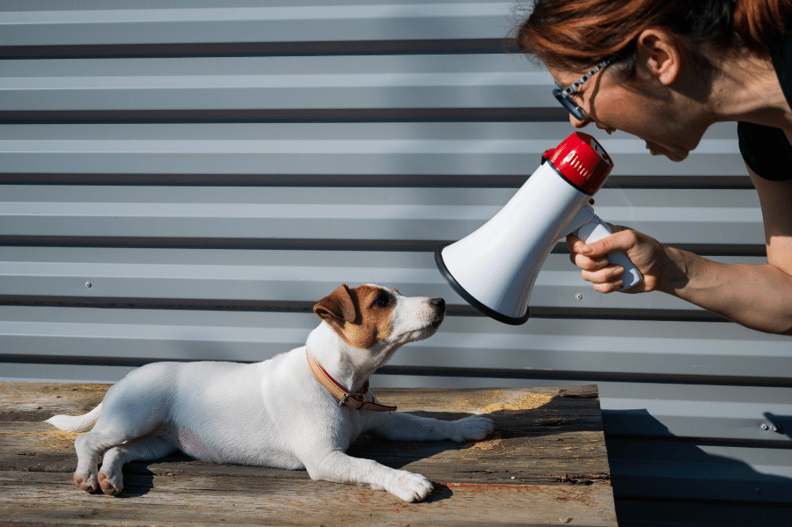
While it would be lovely if a dog could become fully trained in an afternoon, that is not the case. It can sometimes take multiple months for a dog to become fully trained, though this depends on many variables of course. As a result, being patient is incredibly important to the training process. Your dog is likely still warming up to its new living arrangement; add training to that, and it can be a stressful time for the dog.
If you get upset with the dog every time it doesn’t get something right the first time, it will only make the whole process much more difficult. Also, don’t take things personally, your dog certainly isn’t purposely failing to annoy you, it just needs some more work, time and encouragement. If you find your patience wearing thin, it is best to stop the training session for the day instead of lashing out.
4. Eliminate Distractions
The number one inhibitors of a successful training session are distractions. Just like people, dogs can often get distracted by a variety of things. Because of this, it’s a good idea to eliminate distractions when possible during training sessions. Keep their toys away, close the windows and try to do it in quiet places away from your children or other pets.
Also, even without distractions dogs will eventually lose their focus and become more difficult to train. In general, keeping your training sessions to around 10-15 minutes is the sweet spot. Anything longer and many pets will begin to get distracted by anything and everything.
5. Be Consistent
Repetition is important. For your puppy to associate routine and behaviours with rewards and verbal commands, then you need to be very consistent. Keeping a regular schedule for feeding, potty breaks, physical activity, and downtime are all going to provide structure to help your dog learn.
Different types of training may work better than others for your dog. Treat training is the most common, but clicker training offers a consistent audio cue that your dog will associate with a reward. This helps him identify when he’s correctly responded to your verbal commands.
6. Be Concise
Dogs can learn a variety of words and phrases, but when you first start your training, their capacity for the English language is very basic. When teaching beginner commands and behaviours, it’s best to stick to easy one-word verbal commands.
Words like sit, stay, down, and paw are some of the most common commands for puppies that are starting basic training. Using full sentences, or multi-step commands will just confuse your puppy, and he may not be able to associate the words with the action.
7. Wait for it…
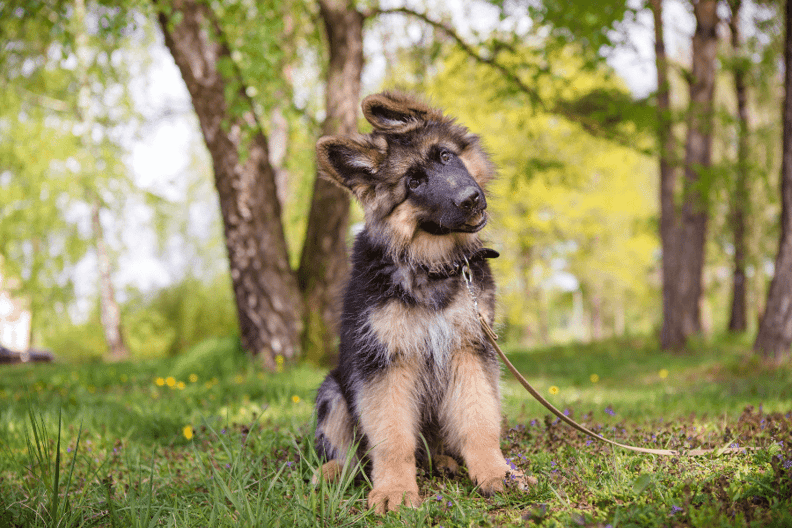
When you ask a basic command of your dog, give him a few seconds to react. Sometimes they just need a minute to put the pieces together. Whether your dog is being stubborn or is just trying to figure out what you are asking, a brief pause after verbal commands will do wonders for training.
Rapidly repeating the command over and over might just confuse him more. Instead of- “sit, Sit, SIT, SIT!! – and getting more and more frustrated in your tone, say it once and count to five in your head. If he hasn’t responded, try again with a visual aid like a hand motion.
8. Get the Right Gear
Training is easier when you have the right training aids. Regardless of your training style, having the right tools will help you connect with your pup better and help to keep him engaged. It can be as simple as a treat pouch to keep rewards nearby and easy to grab, or a comfortable and well-fitted harness, like the Ruffwear Front Range Harness.
Training requires some preparation, but when you have the right gear, you can find a variety of opportunities to incorporate training into your everyday activities.
9. Ask for Help
Some dogs need more training than you might be able to give on your own. Don’t be afraid to connect with a trainer, your vet, or your local pet community for advice and help. Some behavioural issues, like anxiety, can make training very difficult.
Seeking professional help is more than just teaching your dog, it’s about teaching you too. Trainers and classes can give you the methods and tips to confidently continue your dog’s training at home.
10. End on a Positive Note
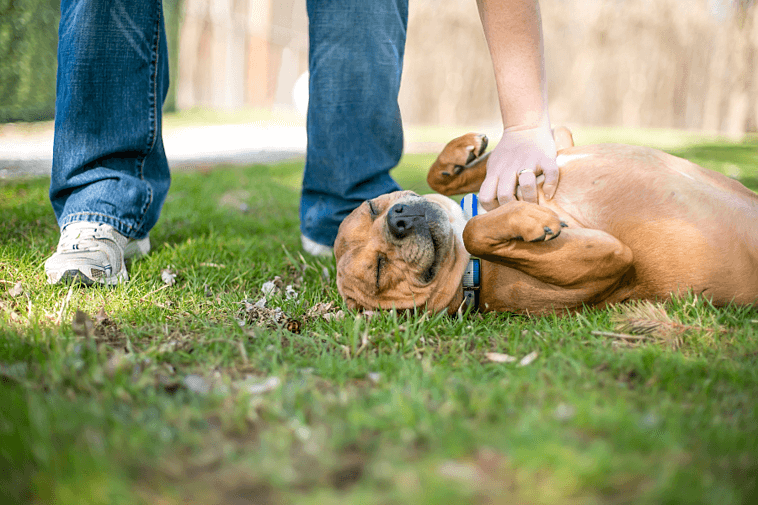
When you end any training session that had decently successful results, it is important to end on a positive note. Your dog has spent a lot of time trying to impress you and work with you, and you need to show your appreciation.
This can be shown in a variety of different ways, from handing out a few tasty dog treats, to petting or playing with the dog for a little bit.
How you leave a session can often set the tone for the next, so keep that in mind. You want the dog to associate the training time with happiness and fun, not anger and sadness. Ending on a good note will ensure the dog is open to the next session and will be ready to go.
Learning how to train a dog is a great bonding experience for you and your four-legged buddy. No matter the behaviour you are trying to train, the tips in this article will be able to help. These are far from the only free dog training tips to help you succeed, but are some of the most important to keep in mind for the best results.





